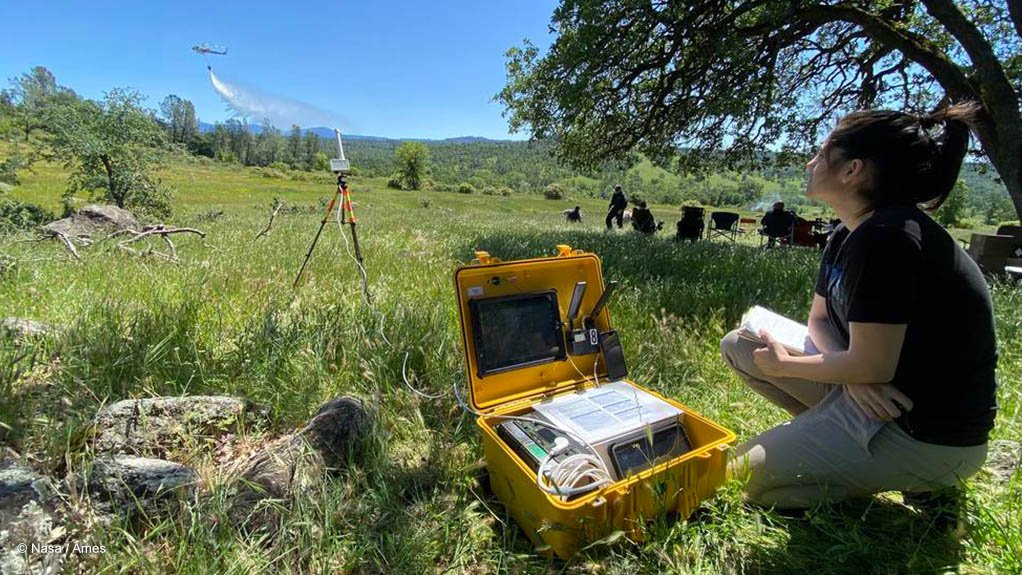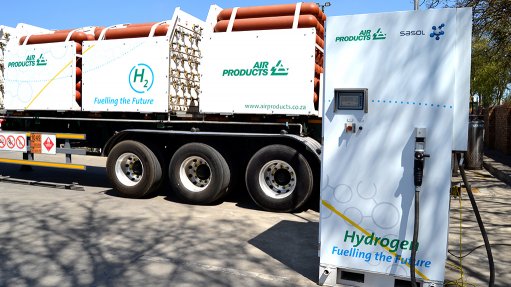Nasa research project seeks to enable drones to serve as firefighters


Nasa Ames Research Centre research associate Yasmin Arbab testing a prototype firefighting drone “pilot’s kit” (the drone is not visible; in the background, a crewed helicopter carries out a firefighting training exercise)
Photo by Nasa/Ames Research Centre
The US National Aeronautics and Space Administration (Nasa) is currently running a project to use uncrewed aerial vehicles, popularly called drones, to improve both the coordination of forest and grassland firefighting operations and the direct suppression of such fires. Although the project is focused on American requirements, particularly those of the US Forest Service (USFS), it would obviously be applicable to many other countries, including South Africa.
According to the USFS, forest and grassland fires burn some 1.5-million acres (about 607 000 ha, or more than 6 000 km2) of vegetation every year, in the US alone. Supressing these fires has cost an average (over a five-year period) of $2.9-billion. And these fires also release large amounts of carbon dioxide into the atmosphere.
Fighting such fires is complex, requiring aircraft as well as ground teams. In the case of the US, for each fire these aircraft can number in the dozens and be operated by multiple government agencies, at both federal and state level. Coordination of all these air assets, and coordination between the air and ground firefighting teams, is both essential and complex. (In other countries, such as South Africa, the scale of such operations may be less, but they remain complex and coordination remains essential.)
Further, crewed firefighting aircraft can only operate when they have adequate visibility, to minimise the risk of colliding with each other or of flying into the ground. That means they cannot operate at night or when the smoke from the fire is too dense.
“Drones can help expand the window of time available for aerial [fire] suppression because they can be safely operated by pilots on the ground,” pointed out Nasa. “Using drones for aerial suppression operations would reduce safety risks to pilots and make aerial wildfire operations more effective.”
However, a major problem in the use of drones for such missions is the current lack of situational awareness, regarding their location, on the part of their operators. This not only greatly reduces their effectiveness, but also increases the risk of aerial collisions.
To address these issues, Nasa’s Ames Research Centre (located in California’s Silicon Valley) is leading the agency’s Advanced Capabilities for Emergency Response Operations (ACERO) project. This is developing airspace management technologies which will share information between drone operators, crewed aircraft and ground-based fire-fighting teams. All of them would have the same situational awareness; it will also ensure ‘de-confliction’ in the air operations. ACERO has also developed aircraft safety software, which will also reduce the risks of air-to-air collisions.
These technologies will allow the complete integration of drones into firefighting operations. And this, in turn, will allow uninterrupted aerial monitoring and suppression of a fire, regardless of visibility levels.
“Drones could also be used for prescribed burns, or fires set and controlled by experts designed to burn away the dead brush that acts as fuels and can lead to large-scale wildland fires,” added Nasa. “Currently, these types of burns are set by a combination of piloted helicopters, ground crew, and a very limited amount of drones. Remotely operating drones for these operations would be safer and cheaper than deploying ground crews and helicopters. It would also enable crews to execute controlled burns over larger acreages of land each year.”
Comments
Press Office
Announcements
What's On
Subscribe to improve your user experience...
Option 1 (equivalent of R125 a month):
Receive a weekly copy of Creamer Media's Engineering News & Mining Weekly magazine
(print copy for those in South Africa and e-magazine for those outside of South Africa)
Receive daily email newsletters
Access to full search results
Access archive of magazine back copies
Access to Projects in Progress
Access to ONE Research Report of your choice in PDF format
Option 2 (equivalent of R375 a month):
All benefits from Option 1
PLUS
Access to Creamer Media's Research Channel Africa for ALL Research Reports, in PDF format, on various industrial and mining sectors
including Electricity; Water; Energy Transition; Hydrogen; Roads, Rail and Ports; Coal; Gold; Platinum; Battery Metals; etc.
Already a subscriber?
Forgotten your password?
Receive weekly copy of Creamer Media's Engineering News & Mining Weekly magazine (print copy for those in South Africa and e-magazine for those outside of South Africa)
➕
Recieve daily email newsletters
➕
Access to full search results
➕
Access archive of magazine back copies
➕
Access to Projects in Progress
➕
Access to ONE Research Report of your choice in PDF format
RESEARCH CHANNEL AFRICA
R4500 (equivalent of R375 a month)
SUBSCRIBEAll benefits from Option 1
➕
Access to Creamer Media's Research Channel Africa for ALL Research Reports on various industrial and mining sectors, in PDF format, including on:
Electricity
➕
Water
➕
Energy Transition
➕
Hydrogen
➕
Roads, Rail and Ports
➕
Coal
➕
Gold
➕
Platinum
➕
Battery Metals
➕
etc.
Receive all benefits from Option 1 or Option 2 delivered to numerous people at your company
➕
Multiple User names and Passwords for simultaneous log-ins
➕
Intranet integration access to all in your organisation



















